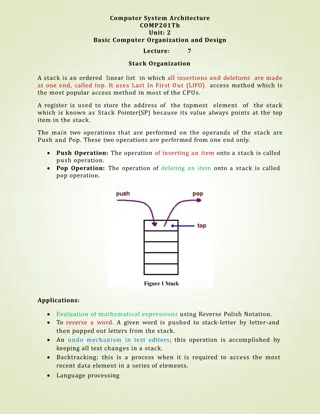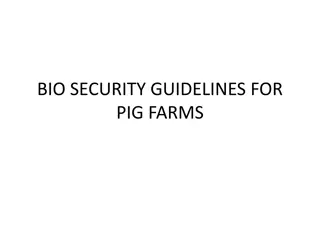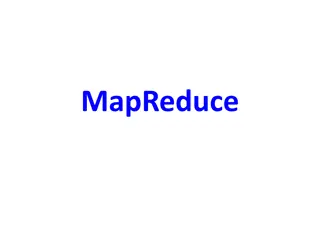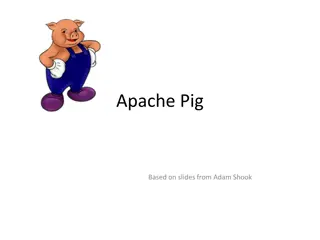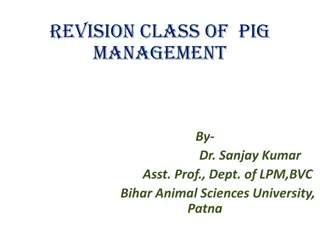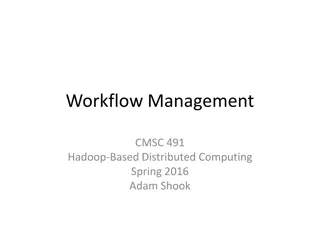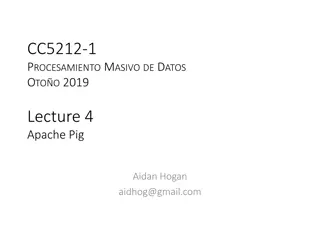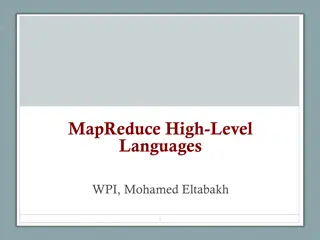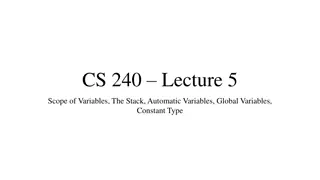Introduction to Pig Latin for Data Processing in Hadoop Stack
Pig Latin is a dataflow language and execution system that simplifies composing workflows of multiple Map-Reduce jobs. This system allows chaining together multiple Map-Reduce runs with compact statements akin to SQL, optimizing the order of operations for efficiency. Alongside Pig Latin, the Hadoop Stack also features data analysis systems like HBase and Spark to enhance data processing capabilities. References include academic works on Pig Latin and high-level dataflow systems built on Map-Reduce. Dataflow programming in this context involves transforming multiple data items from input to output in a directed graph setup, offering a streamlined approach to data processing compared to traditional procedural programming.
Download Presentation

Please find below an Image/Link to download the presentation.
The content on the website is provided AS IS for your information and personal use only. It may not be sold, licensed, or shared on other websites without obtaining consent from the author. Download presentation by click this link. If you encounter any issues during the download, it is possible that the publisher has removed the file from their server.
E N D
Presentation Transcript
The Hadoop Stack, Part 1 Introduction to Pig Latin CSE 40822 Cloud Computing Fall 2014 Prof. Douglas Thain University of Notre Dame
Three Case Studies Workflow: Pig Latin A dataflow language and execution system that provides an SQL- like way of composing workflows of multiple Map-Reduce jobs. Storage: HBase A NoSQl storage system that brings a higher degree of structure to the flat-file nature of HDFS. Execution: Spark An in-memory data analysis system that can use Hadoop as a persistence layer, enabling algorithms that are not easily expressed in Map-Reduce.
References Christopher Olston, et al, Pig Latin: A Not-so-Foreign Language for Data Processing, SIGMOD 2008. http://dl.acm.org/citation.cfm?id=1376726 Alan Gates et al. Building a high-level dataflow system on top of Map- Reduce: the Pig experience, VLDB 2009. http://dl.acm.org/citation.cfm?id=1687568 Apache Pig Documentation http://pig.apache.org
Pig Latin Overview Map-Reduce programs can be challenging to write, and are limited to performing only one analysis step at a time. Pig Latin: Chain together multiple Map-Reduce runs, each one expressed by a compact statement similar to SQL. By using a high level query language, the system can optimize the order of operations in order to produce a better plan. Pig Pen: Test out queries on sampled data.
Dataflow Programming In a dataflow programming system (an old idea), a program is a directed graph of the steps by which multiple data items are transformed from input to output. The programmer is not responsible for choosing the order in which items are processed. Procedural Programming int A[] = { 10, 20, 30, }; for( i=0; i<1000; i++ ) B[i] = F( A[i] ); for( i=0; i<1000; i++ ) C[i] = G( A[i] ); Dataflow Programming set A = { 10, 20, 30, } set B = apply F(x) to A set C = apply G(x) to A
Sample Objective Find each category that contains more than 10^6 entries with a pagerank of 0.2 or higher. category url pagerank Academic www.nd.edu 3.0 Commercial www.Studebaker.com 1.5 Non-Profit www.redcross.org 5.3 . . . (billions of rows) . . .
If we did it in Map-Reduce: Round One Compute Averages by Category Round Two Collect Results into One File map( data ) { split line into category, url, pagerank if(pagerank>0.2) emit(category,pagerank) } map( data ) { split line into count, category, average if(count>10^6) emit(1,(category)); } reduce( key, list( values ) ) { for each item in list { count++; total+=value; } emit( count, category, total/count ); } reduce( key, list( values ) ) { for each value in list { emit(value); } }
If we did it in SQL SELECT category, AVG(pagerank) FROM urls WHERE pagerank > 0.2 GROUP BY category HAVING COUNT(*) > 10^6 category AVG(pagerank) Academic 1.75 Commercial 0.56 Non-Profit 3.23 . . . . . .
Same thing in Pig Latin urls = LOAD urls.txt AS (url, category, pagerank) good_urls = FILTER urls BY pagerank > 0.2; groups = GROUP good_urls BY category; big_groups = FILTER groups BY COUNT(good_urls)> 10^6; output = FOREACH big_group GENERATE category, AVG(good_urls.pagerank);
Basic Idea Express queries in Pig Latin. Pig translates statements into DAG. DAG is translated into Map-Reduce Jobs. Map-Reduce jobs run in Hadoop. Encourage Unstructured, Nested Data User Defined Functions: A small bit of Java that can be imported into the query language. Could potentially be a large/expensive piece of code.
Normalized Database (SQL) PartID Name Price ProductID Name ProductID PartID Quantity 1 Wheel 10 1 Bicycle 1 1 2 2 Chain 15 2 Tricycle 1 3 1 3 Handlebars 3 3 Unicycle 1 2 1 4 Seat 12 2 1 3 2 3 1 2 4 1 Codd s definitions of normal forms: 1NF - The domain of each attribute contains only atomic values, and the value of each attribute contains only a single value from that domain. 2NF - No non-prime attribute in the table is functionally dependent on a proper subset of any candidate key. 3NF - Every non-prime attribute is non-transitively dependent on every candidate key in the table. The attributes that do not contribute to the description of the primary key are removed from the table. In other words, no transitive dependency is allowed.
{ } Name-> Bicycle , Price -> 105, Parts -> { (1, Wheel , 2, 10.00 ), (2, Chain , 1, 15.00 ), (3, Handlebars , 1, 3.00), }; Name -> Tricycle , Price -> $55, Parts -> { (1, Wheel , 3), (3, Handlebars ,1), } Nested Data (Pig) JSON-Like Syntax: Atom: hello or 25 Ordered Tuple: (a,b,c) Unordered Bag: {a,b,c} Map: {a->x, b->y, c->z}
Operations bag = LOAD file USING format AS (field-list) bag = FILTER bag BY function bag = FOREACH bag GENERATE expression-list bag = DISTINCT bag bag = ORDER bag BY expression-list bag = GROUP bag BY (field-list) bag = COGROUP bag-list BY (field-list) STORE bag INTO file USING format
From Pig to Map-Reduce urls = LOAD urls.txt AS (url, category, pagerank) good_urls = FILTER urls BY pagerank > 0.2; groups = GROUP good_urls BY category; big_groups = FILTER groups BY COUNT(good_urls)> 10^6; output = FOREACH big_group GENERATE category, AVG(good_urls.pagerank); Example on Board: Code -> DAG -> Map-Reduce Jobs
Exercise Given a whole lot of email stored in Hadoop, write a Pig program will yield the list of spammers who have sent 1000 or more pieces of spam email in the last year, and also generate the list of victims who have received more than 1000 items in the last year. Mail from *@nd.edu should never be considered spam. The mail is stored in this form: (sender, receiver, contents, date) You have a function called IsSpam(contents) which returns true if the contents contain spam. (Expensive function.)
Points for Discussion Which operations may be rearranged in the DAG? Is Pig Latin different from SQL in a fundamental way? Or could this have simply been done with slight changes to SQL? Big data systems often recommend data management practices that are completely opposite of those developed by relational database systems. Why?




